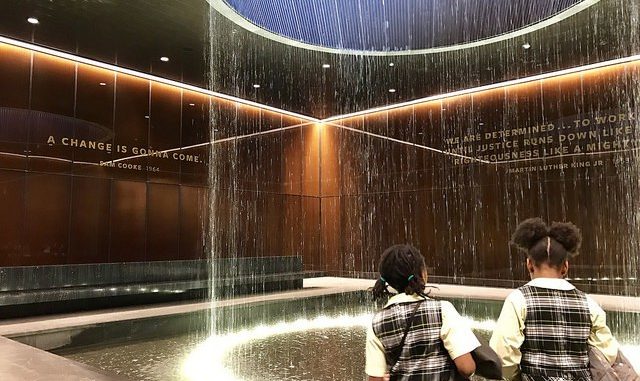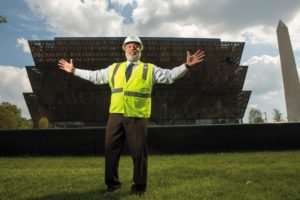

by Rachel Sadon
Since Ruth Odom Bonner joined President Barack Obama in ringing the bell to open the Smithsonian’s National Museum of African American History and Culture last year, more than 2.5 million people have visited the site.”What’s been so moving is that it’s clear after a year, the museum has already become a pilgrimage site,” says Director Lonnie Bunch, who began the “great adventure” of opening the museum in 2005. What followed was more than a decade of building a collection and a building from scratch. It culminated on September 24, 2016 when the daughter of a slave and the nation’s first black president tolled the 500-pound bell that had been lent by the historically black First Baptist Church in Williamsburg, Va. and ushered people in.
Visitors to the African American History and Culture Museum tend to stay more than triple the typical amount of time they spend at most museums. Even a year later, a pass system remains in place to prevent overcrowding, and the free tickets remain difficult to come by (they are released monthly, and a limited number of same-day tickets are available online starting at 6:30 a.m.). The cafe serves up over 1,500 meals a day. Bunch attributes the success in part to a pent up demand—generations worked to get the museum built, and the long-held dream was only fulfilled after more than a century of effort. But he also believes that the way the museum presents its subject matter has a lot to do with it.”It tells the unvarnished truth,” Bunch says. “I think there are people who were stunned that a federal institution could tell the story with complexity, with truth, with tragedy, and sometimes resilience. So I think the kind of honesty of it appeals to people.”
Bunch recently elaborated about what it’s been like to shepherd the museum through its first year.
Q: You worked on this for more than a decade before it opened. What was it like to finally see it open after all that work, gathering all those artifacts, building this up from the ground (really a giant hole in the ground) up?
A: In many ways, it was probably one of the most emotional moments of my life, both professional and personal. To actually not only fulfill a dream of all the staff, but a dream of generations who wanted this, it was really very humbling. But quite honestly it was also very motivating. Whenever you hit a bump or you worry about how you’re going to pull it off, recognizing that I didn’t want to let down all these other generations who had tried, that was a great motivating factor.
Q: You had this moment celebrating the opening, you had the president and all these people who had traveled to D.C., and then it was day one on the grounds. What’s been your experience like shepherding it through this first year?
A: It’s been wonderful in that it’s become, within the first year already, part of the American lexicon. There’s almost no one that doesn’t know about the museum, doesn’t know about how hard it is to get in, or how much they enjoyed it. But also I think that what’s been so moving is that it’s clear after a year, the museum has already become a pilgrimage site—that there are thousands of people who come to share their story with their grandchildren or to connect over an object with people who shared maybe a comparable experience in the Civil Rights movement. I think it’s really become what we wanted, which was to be a place that was as much about today and tomorrow as it is about yesterday.
Q: You’ve had a long museum career. How has this particular museum been different from previous places you’ve worked at?
A: It’s different in that you had to start from scratch—you didn’t have a collection, you didn’t have a building. What it allowed us to do is say “what should a 21st century museum that explores race, what should it do?” So it helped us put the way that museums interpret race on its end. Instead of saying “this is a story about the African American community,” we’re saying “this is a story about America through the lens of the African American community.” And so that’s very different.Being able to start from scratch allowed us to think innovatively about how do you actually collect by working with communities and going into peoples homes, in their trunks and attics. In essence, because we had nothing, it forced us to be different than most museums. We have to be more creative, more nimble.

Be the first to comment